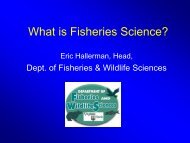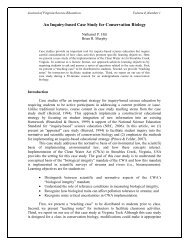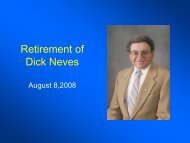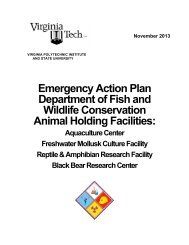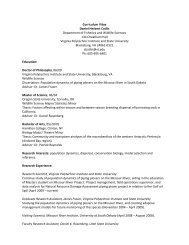Kernel Home Range Estimation for ArcGIS, using VBA - Fish and ...
Kernel Home Range Estimation for ArcGIS, using VBA - Fish and ...
Kernel Home Range Estimation for ArcGIS, using VBA - Fish and ...
Create successful ePaper yourself
Turn your PDF publications into a flip-book with our unique Google optimized e-Paper software.
document or map template may be saved with other names. Data should be loaded into the<br />
document in the <strong>for</strong>m of a shapefile. It is recommended that the data are projected in UTM<br />
meters (ABODE has not been tested with other projections systems yet).<br />
8.2. Using ABODE <strong>for</strong> home range analysis<br />
In order to facilitate the automation of tedious home range analyses, ABODE provides options <strong>for</strong><br />
subsetting datasets. This is equivalent to running batch mode. This allows users to load their<br />
data as a single shapefile into ArcMAP. As an example, one shapefile may have the location<br />
data (x <strong>and</strong> y coordinates), day, month, year, <strong>and</strong> ID <strong>for</strong> all the animals in a population. When<br />
subsetting, the user chooses the field on which to subset (i.e. the ID field), <strong>and</strong> ABODE will then<br />
run the anaylsis <strong>for</strong> the data that have the same value in that field, be<strong>for</strong>e starting new analysis<br />
<strong>for</strong> the next value. Thus, if a dataset has 5 individuals, with IDs “1”, “2”, “3”, “4” <strong>and</strong> “5”, <strong>and</strong> if the<br />
field “ID” is chosen <strong>for</strong> subsetting, ABODE will run the analysis first <strong>for</strong> the records <strong>for</strong> individual<br />
“1” then <strong>for</strong> individual “2” etc, <strong>and</strong> then provide a single table as output containing the results from<br />
the 5 analyses. ABODE can only h<strong>and</strong>le subsetting at one level, but if separate analyses are<br />
desired <strong>for</strong> multiple fields, then the fields in the dataset should be manipulated in either ArcMAP<br />
in the attribute table or in a software package such as MS Excel, MS Access or SAS, be<strong>for</strong>e<br />
being imported back into ArcMAP. In this manner, a yearly analysis by individual is possible by<br />
generated a field (i.e. “IDyear”) in which the ID <strong>and</strong> year are concatenated (individual “1” in year<br />
83 would be 183, <strong>and</strong> year 84 would be 184 etc). Since some of the options in ABODE are date<br />
sensitive (they require day, month <strong>and</strong> year fields) it is suggested that a date field (if available) be<br />
converted to separate fields <strong>for</strong> day, month <strong>and</strong> year. This can be done in MS Excel <strong>using</strong> the<br />
functions ‘=day()’, ‘=month()’ <strong>and</strong> ‘=year()’.<br />
8.2.1. The Visual Basic <strong>for</strong>m <strong>and</strong> error trapping<br />
ABODE was designed to be a relatively simple program with open code. The benefit of this<br />
feature is customization. The field of home range analysis is progressing fairly rapidly. No<br />
estimation techniques are or should be taken as irrefutable truths. Thus, it is anticipated that the<br />
technology <strong>and</strong> theory behind home range estimation will change. In addition to this, no<br />
technique will fit all data. Instead of ‘massaging’ data to fit a technique, techniques should be<br />
developed <strong>and</strong> changed such that we are faithful to our data <strong>and</strong> their capabilities. Written in<br />
Visual Basic <strong>for</strong> Applications <strong>and</strong> ArcObjects, you as a user have the ability to change the code.<br />
The user interface is a simple <strong>for</strong>m in which you enter or select parameters to be used in the<br />
analysis.<br />
46





